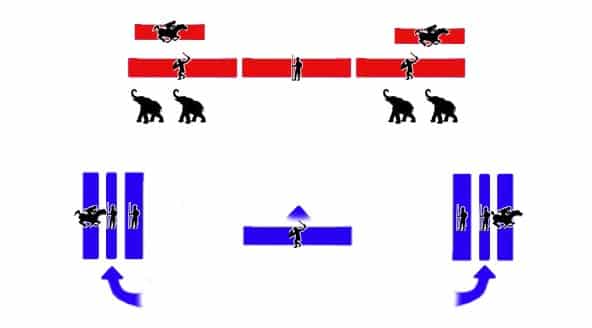The Battle of Ilipa in 206 BC was in my opinon Scipio’s masterpiece.
If Rome had ten years earlier been terribly defeated at Cannae by Hannibal, then Scipio had spent his time training his forces in the wars in Spain. He had learned the lesson so brutally taught by Hannibal and drilled his forces to be able to execute tactical manoeuvers.
The Carthaginian commanders Hasdrubal and Mago led a force of 50’000 to 70’000 infantry and 4’000 cavalry. The dangers an army of this size presented to Rome, whilst Hannibal still loomed large in the south of Italy were obvious. The Spanish territories were key to the outcome of the war. Victory for either side would secure control over Spain.
Scipio met the Carthaginian forces outside the town of Ilipa. The two sides each established their camps at the foot of opposing hill sides. For several days the two sides sized each other up, neither commander deciding on any action. Scipio however was studying his enemy.
He noticed how the Carthaginians always emerged without much haste and arranged their forces in the same way every day. The Libyan crack troops were arranged at the centre. The less well trained Spanish allies, many of them recent recruits, were stationed at the wings. Meanwhile the cavalry was aligned behind those wings.
This array was no doubt the traditional way of lining up your troops. Your strong, best armed forces at the centre, flanked by lighter troops. In order to protect the weaker flanks, Hasdrubal had even positioned his elephants in front of the Spanish allies. Sound tactics one might call them.
Though since Hasdrubal failed in any way to vary these arrangements, he allowed Scipio to predict what his battle order would be on the day when battle finally would take place.
It was a fatal mistake.
1. Scipio’s forces rise early and take to the field

From the lessons Scipio had learned from observing his opponent, he decided to ready his army early in the morning, assure that all had been well fed and then march out. Had he before that day only always lined up his troops in response to Hasdrubal’s larger force, this sudden Roman move now took the Carthaginian commander by surprise.
Unfed and ill prepared the Carthaginians were rushed out to take their positions. Right from the beginning the Roman skirmishers (velites) and cavalry harrassed the Carthaginian positions. Meanwhile behind these goings on, the Roman main force now took up a different arrangement than on the days before. The weaker Spanish auxiliary forces formed the centre, the tough Roman legionaries stood at the sides. On Scipio’s command the skirmishers and cavalry withdrew and drew up behind the legionaries on the flanks of the Roman force.
Battle was about to commence.
2. Roman Wings swing and advance, Roman Centre advances less quickly

What followed was a brilliant tactical move, which left its opposition dazed and confused. The wings, consisting of the legionaries, skirmishers and cavalry, advanced quickly, at the same time performing a 90 degree turn toward the centre.
The Spanish auxiliaries also advanced, but at a slower rate. After all, Scipio didn’t want to bring them into contact with the hardened Libyan forces in the Carthaginian centre.
3. Roman Wings divide and attack

As the two detached, fast-moving wings closed on the opponent, they suddenly split. The legionaries swung back around to their original alignment and now drove into the elephants and the weaker Spanish troops behind them.
The Roman skirmishers and cavalry combined into joint units and swung around 180 degrees to crash into the Carthaginian flanks.
Meanwhile the Libyan infantry in the centre could not turn and fight off the attack, as this would otherwise expose their own flank to the Spanish allies of the Romans looming in front of them. Also they had to contend with the out-of-control elephants which were driven towards the centre.
The Carthaginian forces faced annihilation, but torrential rain came to their rescue, forcing the Romans to retire. Although Carthaginian losses will no doubt have been very heavy.
Scipio’s dazzling manoeuvre simply portrays this commander’s tactical brilliance, as well as the unrivalled competence and discipline of the Roman legion. Faced with a dangerous foe of superior numbers Scipio acted with supreme confidence.
Given the manoeuvres of the Roman army that day, it is of little surprise that Hasdrubal could not respond adequately to counteract the attack. Perhaps there would have been only one commander of the day who possessed the genius to react to such bold tactics – Hannibal. And it is telling that, when faced with that very foe some years later, Scipio did not dare attempt anything comparable to Ilipa.
What is worth pointing out is that Scipio’s battle order not only outwitted his opponent Hasdrubal, but also helped contain any potential trouble by the Spanish allies. Scipio felt he could not completely depend on their loyalty and hence having their forces between the Roman wings helped keep them in check.
The Battle of Ilipa essentially decided which one of the two great powers would dominate Spain. Had the Carthaginians escaped annihilation, they had been severely defeated and could not recover in order to hang on to their Spanish territories.
Scipio’s spectacular victory was one of the decisive moments in the war against Carthage.

Historian Franco Cavazzi dedicated hundreds of hours of his life to creating this website, roman-empire.net as a trove of educational material on this fascinating period of history. His work has been cited in a number of textbooks on the Roman Empire and mentioned on numerous publications such as the New York Times, PBS, The Guardian, and many more.
